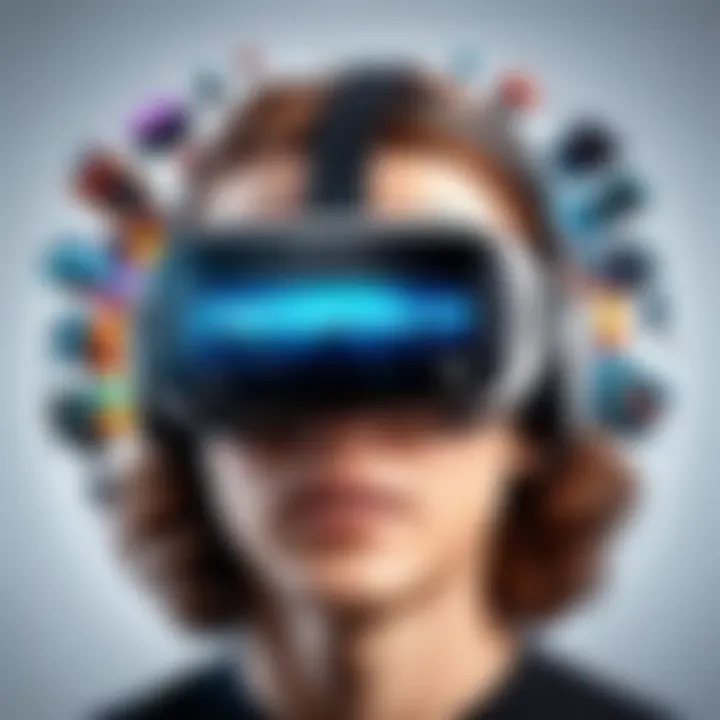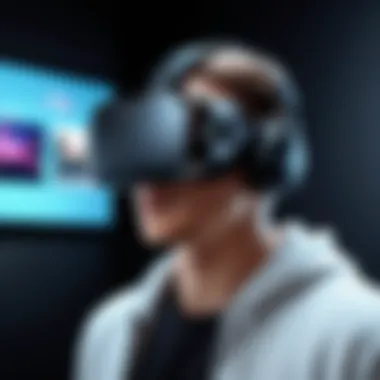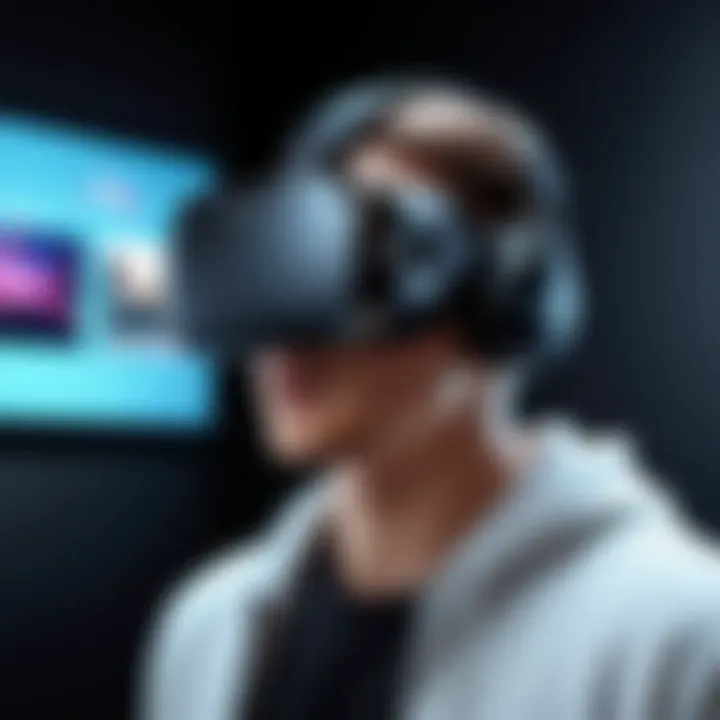The Future of 3D Gaming and Virtual Reality


Intro
The integration of 3D gaming and virtual reality (VR) represents a significant milestone in the evolution of digital entertainment. As both sectors advance, they increasingly influence one another, creating immersive experiences that were previously unimaginable. This article seeks to dissect the current landscape of 3D gaming in VR, exploring the latest technological advancements and user experiences.
Players today expect more than just traditional gaming; they desire engagement through detailed visual environments and interactive gameplay. By examining the features, performance dynamics, and user interface considerations, this exploration will aid information technology professionals and tech enthusiasts in understanding the implications of these technologies. The analysis will cover hardware specifications, software innovations, and the overall impact VR has on the gaming ecosystem.
Profound insights will be presented to assist in making informed decisions regarding the adoption of these technologies in professional settings. The focus will also delve into how VR modifies the conventional gaming experience, ushering in new paradigms for both players and developers alike.
Features Overview
Understanding the features that define 3D gaming in VR is essential for grasping how these technologies work together. As the landscape evolves, several key specifications and unique selling points emerge.
Key Specifications
- Display Resolution: High-resolution displays reduce the screen-door effect, enhancing immersion. Current models boast 4K or higher resolutions.
- Field of View (FOV): Wider fields of view, around 110 degrees or greater, provide a more natural view space, mimicking human vision.
- Tracking Technology: Advanced tracking systems, such as inside-out tracking or external sensor setups, allow for precise movements and interactions within the virtual world.
- Input Methods: Controllers equipped with haptic feedback and gesture recognition enhance the sensory experience and enable sophisticated interaction.
Unique Selling Points
The appeal of 3D gaming in VR can be distilled into several unique selling points:
- Immersive Experience: The most significant draw is the deep level of immersion that VR provides, engaging users in an experience like no other.
- Interactivity: Players can physically interact with their environments, adding a layer of engagement absent in traditional gaming.
- Realism: The combination of advanced graphics and audio design creates realistic environments that enhance player connection and enjoyment.
"Virtual reality is not just a game. It is immersive storytelling that envelops the player in a rich experience."
Performance Analysis
To understand the practical implications of 3D gaming in VR, performance analysis is vital. This analysis includes benchmarking results and real-world scenarios to assess the efficacy of the technology.
Benchmarking Results
Performance metrics such as frame rates, latency, and tracking accuracy are critical. High and consistent frame rates, ideally above 90 frames per second, are necessary to avoid motion sickness and ensure a smooth experience. Assessments of leading VR systems highlight:
- Oculus Quest 2: Frames maintain stability, enabling fluid movement.
- HTC Vive Pro 2: Offers exceptional resolution and tracking fidelity.
Real-world Scenarios
By applying the technology in practical settings, developers and users gather valuable insights. Various scenarios illustrate the benefits of 3D gaming in VR:
- Gaming Competitions: The immersive nature of VR enhances competitive environments, making matches feel more intense.
- Training Simulations: Industries like healthcare and engineering use VR for training, allowing realistic practices without risks.
Historical Context of 3D Gaming
Understanding the historical context of 3D gaming is pivotal in appreciating its current evolution and integration with virtual reality. The legacy of 3D graphics has laid the groundwork for the immersive experiences that VR technology offers today. By examining the origins and developmental journey of 3D gaming, one can better grasp the complexities of both the technology and its user interactions. This context also sheds light on the gradual transformation of player expectations and the rise of immersive environments.
Origins of 3D Graphics
3D graphics have roots that can be traced back to the early days of computing. The foundational developments in 3D rendering began in the late 1960s with basic vector graphics. Notably, the emergence of systems like Sketchpad allowed graphical manipulation of objects in a two-dimensional space. However, as computing power grew, attempts were made to simulate three-dimensional environments.
In the 1980s, technologies like rasterization began to take precedence. This technique enabled more detailed and realistic graphics than the earlier vector-based models. Early gaming instances, such as Battlezone, showcased these developments, introducing players to a simulated 3D battlefield. Furthermore, the rise of graphical user interfaces and dedicated graphics hardware during this time began to shape the gaming landscape significantly.
Evolution through the Decades
The journey of 3D gaming progressed remarkably through the decades, with each era bringing significant advancements.
- 1990s: This decade marked a turning point, as real-time 3D graphics became a staple in video games. Landmark titles such as Doom and Quake pushed the boundaries of architectural rendering and polygrafic count, demonstrating what was technically possible at that time.
- 2000s: The introduction of powerful GPUs revolutionized the gaming experience by allowing for more complex textures and lighting effects. Games like Half-Life 2 exemplified the potential of 3D environments combined with storytelling, user input, and physics.
- 2010s: The integration of social gaming and online elements led to further shifts. The introduction of VR began to take shape with headsets like the Oculus Rift emerging towards the end of the decade, signifying the next evolutionary step for 3D gaming.
The evolution of 3D graphics illustrates a continuous interplay between technological advancements and user expectations, culminating in today's immersive VR experiences.
As we move to modern technologies, understanding this historical context will help in addressing the synergy between 3D gaming and VR. Each phase provided crucial insights that now define the 3D gaming landscape and offer a foundation for future innovations.
The Rise of Virtual Reality
The emergence of virtual reality marks a pivotal evolution in how technology intersects with human creativity and interaction. This section discusses the rise of VR technology, offering insight into the impact and relevance of VR within the context of 3D gaming. As immersive experiences become increasingly essential, understanding the development of VR provides valuable context for its application in gaming and beyond.
Early Developments in VR Technology
The foundation of virtual reality can be traced back to several innovations in the latter half of the 20th century. Early concepts were supported by rudimentary technology that paved the way for future advancements.
Devices like the Sensorama, invented by Morton Heilig in the 1960s, exemplified initial attempts to create immersive experiences. The Sensorama provided sights, sounds, and even smells to enhance the sensation of reality. Despite these early efforts, practical usage in gaming did not materialize for decades.
In the 1980s, more sophisticated systems began to surface. Notably, Jaron Lanier, with his company VPL Research, introduced the EyePhone and Data Glove, which allowed users to interact with virtual environments in a more tangible manner. Although these units were quite limited and expensive, they introduced concepts still prevalent in current VR technology.
In the following years, the technology languished due to high costs and limited capabilities, making it primarily a novelty rather than a practical gaming solution. However, persistence in research and innovation eventually led to breakthroughs in hardware and software that would reshape the landscape.
Modern VR Platforms
Today, the landscape of virtual reality is vastly different. Modern VR platforms exhibit impressive advancements that enhance user experience and accessibility. Companies such as Oculus, HTC, and Valve have developed systems that provide compelling and immersive environments.
Oculus Rift, for example, launched in 2016, marked a significant milestone with its consumer-ready headset. It provided high-resolution visuals, low latency, and a comfortable design, allowing for a more engaging experience in both gaming and other applications. Similarly, HTC Vive integrated room-scale VR, permitting users to interact naturally with their surroundings, thus elevating the immersive quality of games.
The development of standalone headsets like the Oculus Quest has further illustrated the evolution of VR technology by removing the necessity for tethering to powerful PCs or consoles. This portability opens avenues for broader adoption and varied applications beyond traditional gaming, including education, training, and therapy.
Many contemporary VR platforms incorporate social aspects, enabling gamers to connect and interact within shared virtual spaces. This shift highlights a growing recognition of the community's role in gaming, further enriching the overall experience.
"Virtual reality continues to redefine the boundaries of interactive entertainment, merging technology and creativity in unprecedented ways."
3D Gaming Mechanics
Understanding 3D gaming mechanics is essential in today’s virtual reality landscape. This section explores several core principles and user interactions central to creating immersive experiences. As technology evolves, the mechanics behind 3D gaming significantly enhance how players engage with virtual environments. These elements are vital for developers, particularly when designing games that foster user connection and satisfaction.
Core Principles of 3D Design
3D design revolves around several foundational concepts that underpin the functionality of games. These include:
- Spatial Awareness: Players need to perceive objects and their relationships within a virtual space. This understanding influences movement and interaction, making it vital for seamless gameplay.
- Depth Perception: The ability to gauge distances is crucial. Effective use of scale and perspective creates a realistic experience, making virtual worlds more engaging.
- Lighting and Texturing: Proper use of lighting effects and textures adds depth and realism. These elements enhance visual appeal and significantly impact how players experience and interpret a 3D environment.


Without these principles, a game may feel flat or disorientating. Developers must carefully consider how each aspect contributes to overall experience.
User Interaction in 3D Environments
User interaction is pivotal in defining the gaming experience. Interaction in 3D environments involves various methods and techniques that allow players to manipulate their surroundings. The following points highlight important aspects:
- Control Schemes: Developers often implement specific control schemes that suit the game genre. These can include traditional gamepads or more innovative options such as motion tracking or gesture recognition. A robust control system is necessary for an engaging experience.
- Feedback Mechanisms: Providing real-time feedback enhances immersion. Visual feedback, audio cues, and haptic responses inform players of their actions, reinforcing a connection with the game world.
- Environmental Interactions: The ability to interact with the environment creates richness in gameplay. Players should feel as though their actions within the 3D space have consequences. Considerations for how objects react to user interactions play a significant role in game design.
The Intersection of 3D Gaming and VR
The integration of 3D gaming and virtual reality marks a significant milestone in the evolution of interactive entertainment. By blending these two advanced technologies, developers create immersive experiences that enhance the way users engage with virtual environments. This intersection is not just about visual appeal; it involves fundamental shifts in gameplay design, user interaction, and overall user experience. The importance of exploring this convergence lies in understanding how these technologies serve as catalysts for innovation in the gaming landscape.
Synergy Between Technologies
The synergy between 3D gaming and VR arises from their complementary features. 3D graphics provide depth and realism, while VR technology promotes immersion and interactivity. Together, they create an experience that can be far more engaging than traditional 2D games. For instance, players can look around, interact with the environment, and even manipulate objects in ways that mimic real-life interactions. This enriched sensory experience can lead to a deeper emotional connection to the game.
Benefits of this synergy include:
- Enhanced Realism: 3D graphics combined with VR create a believable and immersive environment.
- Interactive Gameplay: Players can engage in a more tactile way, manipulating items within the game world.
- Broader Storytelling Opportunities: 3D VR allows for more narrative-driven experiences, where players feel integral to the story being told.
Developers must consider how to effectively leverage these elements to maximize user engagement. Addressing technical challenges often arises, but successful integration can lead to groundbreaking results. The success of platforms like Oculus and HTC Vive can be attributed to their ability to combine high-quality 3D environments with immersive VR experiences.
Impact on Gameplay Experience
The impact of merging 3D gaming with VR extends beyond visual upgrades. It transforms the gameplay experience fundamentally. Players encounter new dimensions of gameplay where every glance and movement can influence their engagement with the game.
One critical aspect is the shift in how players experience spatial awareness. Traditional gaming often confines players to predetermined viewing angles; however, VR allows players to explore their environment freely. Some notable impacts include:
- Heightened Engagement: The immersive nature keeps players more focused.
- Improved Navigation: Users can move in and out of their environments, offering a more intuitive interaction model.
- Realistic Feedback: Physical movements result in on-screen actions, bridging the gap between the physical and digital realms.
This transformation in gameplay does present challenges. Developers must balance visual fidelity with performance. Optimizing the graphics for seamless interactions without compromising frame rates is essential. As such, VR developers must prioritize user experience while ensuring smooth gameplay across different hardware setups.
The ecosystem of 3D gaming in VR continues to evolve. Understanding these dynamics reveals not just how to create better games but also how to prepare for future developments in technology. This intersection undoubtedly represents the future of gaming, highlighting the potential for innovative gameplay approaches and richer user experiences.
Technological Innovations
Technological innovations in the realms of 3D gaming and virtual reality are pivotal. They not only drive the advancement of gaming but also redefine user experiences. This section will delve into crucial innovations, focusing on specific elements that enhance gameplay and immersion while considering the implications for developers and users.
Hardware Developments in VR Gaming
Hardware has seen remarkable progress over the last few years. VR headsets are now more comfortable, accessible and feature rich. The introduction of devices like the Oculus Quest 2 and the Valve Index has marked a shift from tethered setups to wireless experiences. This transition allows for a more immersive environment, enhancing gameplay by providing freedom of movement.
Moreover, advancements in haptic feedback technology contribute significantly. Devices now offer tactile sensations that mimic in-game actions. This capability adds a layer of realism that can significantly enhance player engagement.
Important hardware elements include:
- Improved Display Technology: Higher resolutions and refresh rates lead to more visually appealing experiences. This reduction in the screen door effect is crucial for immersion.
- Inside-Out Tracking Systems: Eliminating the need for external sensors streamlines setup. This flexibility is attractive for users with limited space.
- Ergonomic Designs: Priority on user comfort has increased. Better-fitting headsets help to maintain lengthy play sessions without causing discomfort.
In summary, hardware developments not only enhance user experience but also expand the demographic that can engage in VR gaming.
Advancements in Graphics Processing
The graphical fidelity of 3D virtual reality games continues to evolve, driven largely by advancements in graphics processing. Powerful GPUs, such as NVIDIA's RTX series, equipped with real-time ray tracing capabilities, are enabling developers to create richer environments and lifelike animations. This technology enhances lighting, shadows, and reflections, creating visually stunning experiences that pull players into immersive worlds.
Moreover, the move towards more efficient graphics processing units (GPUs) allows for enhanced performance without sacrificing quality. Game developers are no longer constrained to lower frame rates or poorer visual quality, leading to smoother gameplay overall.
Benefits of these advancements include:
- Realistic Environments: Enhanced graphical capabilities lead to more believable worlds, boosting player engagement.
- Higher Frame Rates: Smooth gameplay is crucial in 3D environments. A higher frame rate ensures that movements feel natural and responsive.
- Support for Complex Designs: Developers can implement intricate details in game design and characters, which were not feasible before.
Software Ecosystem
The software ecosystem in 3D gaming and virtual reality (VR) is crucial for understanding how these technologies function together. It encompasses various components that interact to create immersive experiences for players. An effective software ecosystem includes game engines, development frameworks, tools, and platforms that enable developers to build, test, and deploy VR applications. This section will examine the essential elements of the software ecosystem, detailing how they benefit developers and enhance user engagement.
Game engines serve as the backbone of VR development. They provide the necessary environment for creating and managing the 3D elements in a virtual space. These engines facilitate rendering, physics simulations, and user interactions. For instance, Unreal Engine and Unity are two popular engines that support high-quality graphics and complex physics, offering robust tools for developers. The choice of a game engine can significantly influence the efficiency of development processes and the overall experience of the end-user.
Not only do these engines optimize development, they also enable cross-platform compatibility. This is particularly important in VR, where users may access content through various devices. Developers are encouraged to consider which engine aligns best with their target audience's hardware capabilities and preferences.
Besides game engines, development frameworks play a significant role in shaping the software ecosystem. Frameworks such as OpenVR and SteamVR provide the foundational support needed for developers to create VR experiences. These frameworks streamline the integration of hardware and software, allowing developers to focus on content creation rather than technical challenges.
Additionally, the software ecosystem includes source control and project management tools like Git and Trello. These tools aid in collaboration among teams, keeping track of changes and ensuring efficient workflow during the development phase.
In summary, the software ecosystem is intricate and indispensable for the success of 3D VR gaming. It allows developers to leverage existing tools and technologies, fostering innovation and creativity. As the industry continues to evolve, so too will the software ecosystem, adapting to meet emerging demands and enhancing the overall gaming experience.
Game Engines Supporting VR
Game engines are at the core of VR development. They offer a user-friendly interface and powerful capabilities that simplify the creation of 3D environments. When considering game engines, it is critical to assess their support for VR hardware. For instance, both Unity and Unreal Engine have extensive libraries and plugins that simplify VR development.
These engines often provide features such as:
- Real-time rendering to create instantaneous feedback for users
- Built-in physics systems that simulate real-world interactions
- Variety of assets and tools that facilitate rapid development
Using these engines can enhance not only the development cycle but also the end-user experience by providing high-quality visuals and seamless interaction. The choice of engine can impact game fidelity and user immersion significantly.
Development Frameworks for 3D Graphics
Development frameworks provide essential tools for creating 3D graphics within VR environments. Frameworks like OpenGL and DirectX facilitate lower-level graphics programming. These are often used in conjunction with game engines, offering flexibility and control.
Authentication and user interactions also rely on these frameworks, as they ensure the performance of graphics in real-time applications. Moreover, new frameworks designed specifically for VR, such as A-Frame and Babylon.js, simplify the process of building virtual environments.
User Experience in 3D VR Gaming
User experience (UX) in 3D VR gaming is a critical factor that influences how players interact with virtual environments. It encompasses many elements, including usability, enjoyment, and emotional engagement. The unique immersive qualities of VR present both exciting opportunities and specific challenges. This section discusses the importance of UX, focusing on elements that enhance player satisfaction and gameplay.
Designing User-Centric Interfaces
Creating user-centric interfaces is paramount for effective 3D VR gaming experiences. The design must prioritize intuitive navigation and interaction. Users should easily understand how to control their avatars and interact with the game's world. This includes using clear visual cues and ergonomically designed controllers. 3D spatial awareness is crucial. An interface that leverages the virtual space can elevate user experiences.


Considerations for designing these interfaces include:
- Consistency in User Controls: Players benefit from predictable interaction patterns. Using similar controls across various games or even within the same game can help reduce learning time.
- Feedback Mechanisms: Providing immediate feedback for actions reinforces a sense of agency. Whether through auditory signals, haptic responses, or visual effects, feedback should be clear and responsive.
- Visual Clarity: Design should avoid clutter. A well-organized interface helps players stay focused on the gameplay rather than trying to decipher complex menus.
UX should be tested through user studies with real players. Feedback can guide improvements, ensuring that interfaces meet the needs of diverse audiences.
Accessibility in VR Environments
Accessibility in VR environments is essential for inclusive gaming experiences. This entails designing games that everyone can enjoy, regardless of physical or cognitive abilities. Developers must consider various factors that affect accessibility. Some include:
- Adaptive Controls: Offering multiple control schemes accommodates users with differing abilities. This can involve voice commands, eye-tracking technology, or customizable controller layouts.
- Visual and Auditory Options: Ensuring that players with visual impairments can interact with the game through auditory cues or haptic feedback is crucial. Similarly, adequate options for subtitle displays cater to users who are deaf or hard of hearing.
- Environment Design: Games should avoid scenarios that induce discomfort or disorientation for sensitive players. Environments should be clear and adaptable to different users' needs.
Accessibility is not merely an add-on but a crucial part of creating a practical gaming environment.
Encouraging accessibility increases the market potential for 3D VR games. It attracts a broader audience, leading to a richer community experience. Designers who prioritize these aspects greatly enhance the overall user experience in 3D VR gaming.
Market Trends and Projections
The convergence of 3D gaming and virtual reality (VR) is a compelling area of study for IT professionals and tech enthusiasts. Understanding market trends and projections is essential for grasping how these technologies evolve and influence the gaming landscape. The significance lies not only in current practices but also in anticipating future developments. By analyzing consumer behavior, technological adoption, and emerging trends, one can gauge the direction of the industry and make informed decisions regarding investments or developments.
Consumer Adoption Rates
Consumer adoption rates are a foundational element when assessing the health of the VR gaming market. Recent surveys show that the acceptance of VR gaming has steadily increased over the past few years, fueled by advancements in technology and a declining price of entry. The data indicates that a larger segment of the population now owns VR-compatible hardware, such as Oculus Quest 2 and PlayStation VR. These factors both encourage and influence game developers to create immersive experiences.
For instance:
- Demographic Engagement: Younger audiences, especially teens and young adults, are showing greater interest in VR.
- Community Influence: Platforms like Facebook and Reddit facilitate community sharing, thereby encouraging new users to engage in VR content.
- Hardware Improvement: Continuous upgrades in hardware capabilities improve user experience, leading to higher satisfaction.
"Understanding consumer psychology is integral to predicting future adoption trends in VR gaming."
Future of 3D Gaming in VR
The future of 3D gaming in VR holds tremendous potential. Technological advancements continue to refine immersive experiences. As hardware becomes more accessible and software innovations emerge, the intersection of these elements suggests notable changes ahead. Several key points highlight anticipated developments:
- Enhanced Immersion: Improved graphics and haptic feedback systems will create more realistic experiences, drawing players deeper into virtual worlds.
- Cross-Platform Play: This trend is rising in popularity, allowing gamers on different devices to interact with one another. This increases the community and keeps the gaming environment vibrant.
- Innovation in Game Design: Expect to see an increase in narrative-driven games that leverage VR’s unique capabilities to tell stories in engaging ways.
- Expansion into Non-Gaming Applications: Industries such as education, health care, and virtual commerce are beginning to exploit VR’s capabilities, further driving the need for robust 3D gaming frameworks.
The synergy between gaming and non-gaming sectors increases the relevance of VR, cementing its position in future technological advancements. Stakeholders must remain informed about these trends to leverage opportunities and navigate challenges effectively.
Challenges and Limitations
Understanding the challenges and limitations inherent in the integration of 3D gaming and virtual reality (VR) is crucial for both developers and users. This section delves into the specific obstacles faced within this domain, particularly focusing on two vital areas: Technical Barriers to Entry and User Experience Obstacles. Recognizing these challenges enables stakeholders to mitigate risks and create more effective gaming experiences.
Technical Barriers to Entry
Technical barriers to entry in VR gaming encompass various factors that may hinder both development and consumer accessibility. The hardware required for immersive experiences is often costly and demands significant computing power. Many users may not have the necessary systems or high-end graphics cards to support these applications.
- Cost of VR Equipment: The financial investment for VR headsets, controllers, and related accessories can be prohibitively high. For example, the Meta Quest Pro and Valve Index offer high-quality experiences but are priced at a premium. This financial barrier limits widespread adoption among casual gamers.
- Hardware Compatibility: Compatibility issues may arise when users attempt to run VR games on older systems. Newer games may require updated specifications that consumers do not possess, leading to frustration and potential abandonment of VR as a platform.
- Development Complexity: Creating a VR game is inherently more complex than traditional gaming. It demands expertise in areas such as spatial audio, motion tracking, and graphics rendering. This complexity can deter smaller developers from entering the VR space.
"As the VR landscape evolves, addressing these technical barriers will be essential for expanding its user base and enhancing overall experience."
Overall, resolving these technical barriers is significant for creating an inclusive and thriving VR gaming environment. Developers need to focus on optimizing their games for a wider range of hardware, while hardware manufacturers should work towards reducing costs and improving standardization.
User Experience Obstacles
User experience obstacles in 3D VR gaming present critical challenges that can affect player satisfaction and engagement. VR, while immersive, introduces unique interaction and comfort issues that can frustrate users.
- Motion Sickness: Many players experience motion sickness during VR gameplay. The disconnect between visual motion and physical stillness can lead to discomfort. Developers must consider comfort settings and variable options to mitigate this issue.
- User Interface Design: Creating intuitive user interfaces in 3D environments can be complex. Many existing games struggle with navigation and control schemes that confuse users rather than assist them. Simple, yet effective design strategies must be employed to ensure ease of use.
- Learning Curve: The learning curve for new users can be steep. Players who are unfamiliar with VR technology may find it daunting. Effective onboarding processes are critical for teaching players how to navigate and interact within VR worlds effortlessly.
Understanding and addressing these user experience obstacles is essential. It is not enough for games to be technologically advanced; they must also be designed with the user in mind. Improvements in these areas will lead to greater player satisfaction and, ultimately, wider adoption of 3D VR gaming.
Impact on the Gaming Industry
The integration of 3D gaming and virtual reality (VR) has profound implications for the gaming industry. This section will dissect the economic implications and shifts in game development practices that arise from these technological advancements.
Economic Implications
The emergence of 3D gaming in VR introduces new revenue streams and business models. Traditional gaming markets are evolving with the introduction of immersive experiences, impacting user engagement and satisfaction. Players are willing to invest more in hardware and games that offer unique experiences. In this sense, VR has not only elevated user expectations but has also expanded potential markets. Companies involved in the gaming sector are now exploring opportunities related to VR, creating niche markets like educational gaming or therapeutic applications.
With VR hardware sales climbing, manufacturers like Oculus and HTC are facing increasing demand. This creates a trickle-down effect on various sectors, from hardware manufacturing to software development. In addition, the rise of VR gaming encourages partnerships among developers, hardware producers, and platform owners.
The economic dynamics of this evolution are evident. Companies that adapt quickly can secure profitable footholds. Furthermore, the global gaming market is predicted to surpass billions in the coming years, significantly influenced by immersive technologies. In essence, VR gaming stands to rewrite the rules of economic engagement in the industry.
"The convergence of 3D gaming and VR is transforming not just how games are played, but how they are monetized."
Shifts in Game Development Practices
As 3D gaming adapts to VR, game development practices have undergone significant shifts. Traditional development methodologies are evolving to accommodate the unique challenges and opportunities presented by immersive experiences. Teams are integrating VR-specific design principles into their production processes.
- Cross-Disciplinary Collaborations: Developers must often work alongside experts from various fields, including psychology, ergonomics, and interaction design to create more immersive experiences. This collaboration leads to richer, more engaging games that resonate with players.
- User-Centric Design: The focus is increasingly on user experience. Game developers are prioritizing user feedback to fine-tune gameplay. Iterative design processes have become vital, allowing teams to refine their products based on real-world testing rather than mere speculation.
- Rapid Prototyping: The speed of development has also changed. Teams are employing agile methodologies, allowing for rapid prototyping and testing of gameplay mechanics. This flexibility enables them to innovate quickly, responding to market demands without derailing production schedules.
In summary, the crossover of 3D gaming and virtual reality is urging developers to rethink traditional paradigms. New technologies require fresh methodologies, and adaptation will be crucial for those looking to remain competitive in the rapidly evolving landscape.
Societal Implications of VR Gaming
The recent surge in virtual reality gaming has sparked vital discussions surrounding its societal implications. This section delves into how VR technology influences various aspects of life, shaping social interactions, mental health, and educational frameworks. Understanding these implications is crucial for IT professionals and tech enthusiasts who wish to leverage these technologies responsibly in both their personal and professional spheres.
Psychological Effects of Immersive Gaming
Immersive gaming, particularly through VR, can have significant psychological effects. The depth of engagement in virtual worlds often leads players to experience heightened emotional states. This can sometimes result in positive outcomes, such as increased empathy, as gamers step into diverse roles and narratives. For example, in games like "Half-Life: Alyx," players confront adversities in a simulated environment, enhancing their emotional resilience.
However, the potential for negative outcomes cannot be overlooked. Users may find it difficult to separate the virtual from the real, leading to issues such as addiction or heightened anxiety. Research has shown that prolonged exposure to intense virtual experiences can affect mood and mindset, often requiring moderation and responsible use. Incorporating awareness of these impacts is essential for developers and users alike.
VR Gaming in Educational Contexts
The integration of VR gaming into educational contexts presents both opportunities and challenges. On one hand, immersive technology can transform how students engage with materials. For instance, VR simulations in subjects like science and history allow learners to explore complex concepts or historical events vividly. This can lead to improved understanding and retention, adapting to various learning styles.


On the other hand, the costs associated with VR technology can limit its accessibility in some educational settings. Additionally, educators must be mindful of the content and experiences provided in VR environments to ensure they align with educational goals and do not reinforce negative stereotypes or biases.
Best Practices for Developers
In the realm of 3D gaming in virtual reality, developers stand as the architects of immersive worlds. The choices they make can significantly influence user experiences and the overall quality of games. Implementing best practices is essential for ensuring that games are not only engaging but also functionally sound. By adhering to established guidelines, developers can optimize gameplay, enhance user satisfaction, and ultimately foster a thriving gaming environment.
Adopting User Feedback Mechanisms
User feedback is invaluable in the development process. Understanding players’ experiences helps developers refine their products. Early feedback can highlight issues that may go unnoticed in initial testing phases. Encouraging beta testing within targeted user groups invites insights that can guide design efforts.
Fostering a continuous feedback loop leads to several benefits:
- Identifying Pain Points: Feedback helps pinpoint frustrating elements in gameplay.
- Improving Usability: Developers can optimize controls and mechanics based on user suggestions.
- Enhancing Engagement: Positive player experiences can lead to word-of-mouth promotion and increased player retention.
Inviting diverse user perspectives ensures an inclusive approach to game design. Utilizing tools such as surveys or forums can facilitate detailed conversations. Additionally, developers should remain open to criticism. This willingness to adapt and change shows a commitment to audience satisfaction and game quality.
Cross-Disciplinary Collaboration
Creating a successful 3D VR game often requires expertise beyond traditional game development. Engaging professionals from various fields can elevate a game’s overall experience. Collaboration with designers, sound engineers, and psychologists can contribute to a richer and more captivating environment.
Key aspects of cross-disciplinary collaboration include:
- Innovative Problem Solving: Diverse teams bring varied perspectives, leading to unique solutions.
- Holistic Game Design: Input from different disciplines ensures a unified vision for the game.
- Realistic Feedback: Experts in psychology can help design games that respond better to user emotions.
To facilitate collaboration, organizations should foster an open culture. Regular workshops and brainstorming sessions can engage different disciplines effectively. Tools like Trello or Slack can be useful for project management and communication, ensuring that all voices are heard.
Comparative Analysis of VR Headsets
A thorough comparative analysis of VR headsets is essential for anyone involved in the 3D gaming or virtual reality sectors. This segment will focus on understanding different headsets and how they influence user experiences. The market is saturated with options like the Oculus Quest 2, Valve Index, and HTC Vive Pro. Each headset presents unique features, capabilities, and user considerations.
Evaluating these headsets critically brings insight into which product might suit specific needs or preferences. This also enables game developers to optimize their offerings for compatible platforms and ensure an enhanced gameplay experience for end-users. Ultimately, the goal is to foster better purchasing decisions and development strategies based on real performance data and user feedback.
Feature Set Evaluation
When evaluating the feature set of VR headsets, several key elements come into play. The resolution, field of view, and refresh rate significantly impact the overall experience. For instance, the Oculus Series boasts high resolution, enhancing clarity in games. On the other hand, the Valve Index attention is on a large field of view which can increase immersion through a better peripheral vision.
Other vital aspects include tracking technologies, comfort, and compatibility with various gaming platforms.
- Resolution: Higher resolution leads to sharper images, reducing motion blur.
- Field of View: A larger field of view provides a more immersive experience.
- Tracking System: Systems like inside-out tracking improve user mobility and eliminate the need for external sensors.
- Compatibility: Diverse platform support can widen the audience reach for game developers.
In this analysis, the right balance between these features must be identified to cater to specific gaming experiences and applications.
Performance Metrics Comparison
Performance metrics offer a window into how different headsets perform under various conditions. Performance can be gauged using indicators like latency, frame rates, and tracking accuracy. Ideally, a headset should offer low latency to prevent motion sickness, with higher frame rates for smooth visuals during fast-paced gaming sessions.
"In virtual reality, every millisecond counts; performance can make or break the immersive experience."
Commonly compared metrics include:
- Latency: The delay between user input and headset response. Lower latency is preferable.
- Frame Rate: A higher frame rate ensures smoother motion. Most gamers prefer at least 90 FPS.
- Tracking Accuracy: This determines how well the headset can follow head movements.
By understanding these metrics, developers can tailor their games to perform optimally across devices. Users can also make informed choices based on specific use cases, whether gaming, simulation, or professional applications.
Notable Games in 3D VR Space
Notable games in the 3D VR space play a vital role in illustrating how immersive gaming can transform user experiences. Through these games, players can engage with technology in ways that traditional gaming cannot replicate. This section aims to explore specific titles that have achieved both critical and commercial success, shedding light on their innovations and impact on the gaming landscape.
Analysis of Critically Acclaimed Titles
Several titles have made significant contributions to the 3D VR game genre. These games often incorporate advanced graphics, compelling narratives, and intricate gameplay mechanics, which enhance overall immersion.
Half-Life: Alyx is often cited as a watershed moment for VR gaming. Released by Valve, it expanded the Half-Life universe while utilizing VR technology to deliver a compelling narrative experience. Players navigate a richly detailed environment that feels alive, with interactions that are not only engaging but also innovative. The use of hand-tracking and environmental puzzles showcases the potential of VR. This title demonstrates how a well-executed game can push the boundaries of existing technology.
Another noteworthy game is Boneworks, which emphasizes physics in gameplay. Developed by Stress Level Zero, this game allows players to manipulate objects in the environment realistically. Such freedom is rare in non-VR games, making Boneworks a standout title in showcasing how VR can elevate interactivity. The game is aimed at more experienced players, highlighting the potential for complex and nuanced design in VR gaming.
Beat Saber is also deserving of mention. It has gained massive popularity due to its blend of rhythm and VR gameplay. Players wield lightsaber-like devices to slash through oncoming blocks to the beat of various songs. Its simple mechanics and engaging gameplay appeal to a broad audience, further supporting the notion that VR can accommodate different gaming styles.
Emerging Trends in Game Design
As the landscape of 3D VR gaming evolves, several trends have started to emerge, influencing how developers approach game design. One significant trend is the focus on social interaction within virtual environments. Many new titles feature multiplayer modes that encourage teamwork and competitive play. The social aspect not only enhances user engagement but also fosters community building among players.
In addition, developers are increasingly prioritizing user-friendly interfaces. The complexity of VR mechanics can be daunting for new users. Hence, titles are being designed with intuitive controls and tutorials that facilitate smoother onboarding processes. This approach encourages a wider audience to explore VR gaming without feeling overwhelmed.
Moreover, there is a growing emphasis on storytelling and narrative coherence. Many developers strive to create immersive worlds that captivate players emotionally and intellectually. This trend is evident in titles like The Walking Dead: Saints & Sinners, where the narrative is interwoven with gameplay mechanics, adding layers of depth to the experience.
Finally, the integration of artificial intelligence (AI) in game design has seen a notable rise. AI is being used to create more responsive and engaging non-player characters (NPCs), enhancing the realism of interactions in VR environments. Games that feature intelligent NPCs can create more dynamic and unpredictable gameplay experiences.
In summary, notable games in the 3D VR space not only showcase current technological advancements but also illuminate the path forward for future game design.
By examining these critically acclaimed titles and emerging trends, it becomes evident that the landscape of 3D VR gaming is marked by innovation and the drive for enhanced user experiences. As developers continue to explore the possibilities, the potential for new genres and gameplay styles is vast.
Ending and Future Directions
This section emphasizes the significance of synthesizing insights on 3D gaming and virtual reality, particularly in light of their growing integration. The trends in both sectors underscore the necessity for professionals to adapt and innovate. As technologies continue to evolve, understanding the implications of these advancements is paramount for staying relevant in the industry. The intersection of 3D gaming and VR offers new opportunities, while also presenting various challenges that require thoughtful consideration.
Summation of Key Insights
In reviewing the integration of 3D gaming and virtual reality, several key points emerge:
- Technological Convergence: The relationship between 3D gaming and VR illustrates a significant trend where gaming experiences are becoming increasingly immersive.
- User Experience: Engagement strategies in VR rely heavily on user feedback and adaptability. Enhancing user interfaces continues to be a top priority.
- Market Trends: Observing consumer behaviors reveals that VR adoption is becoming increasingly common, reflecting a shift in gaming dynamics.
The insights gained through this analysis not only highlight advancements but also emphasize the societal implications of immersive gaming environments, which range from psychological effects to educational applications.
Anticipating Technological Advancements
Looking ahead, the trajectory of technological advancements in 3D gaming and VR suggests several critical areas for consideration:
- Hardware Innovations: Continued enhancements in processing power and graphics capabilities will likely redefine user expectations.
- Software Developments: The rise of new game engines will enhance the realism and interactivity of virtual environments.
- Integration of AI: Implementing artificial intelligence in gaming mechanics can provide dynamic and personalized experiences for users.
"The evolution of technological synergism between VR and 3D gaming will potentially create a new paradigm in digital interaction."
As these advancements unfold, the intersection of hardware and software innovations will shape the future of immersive gaming, presenting an exciting landscape for developers and users alike.



